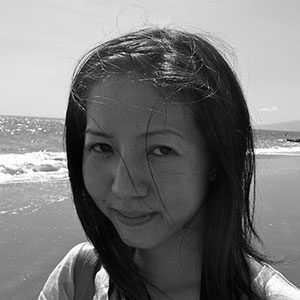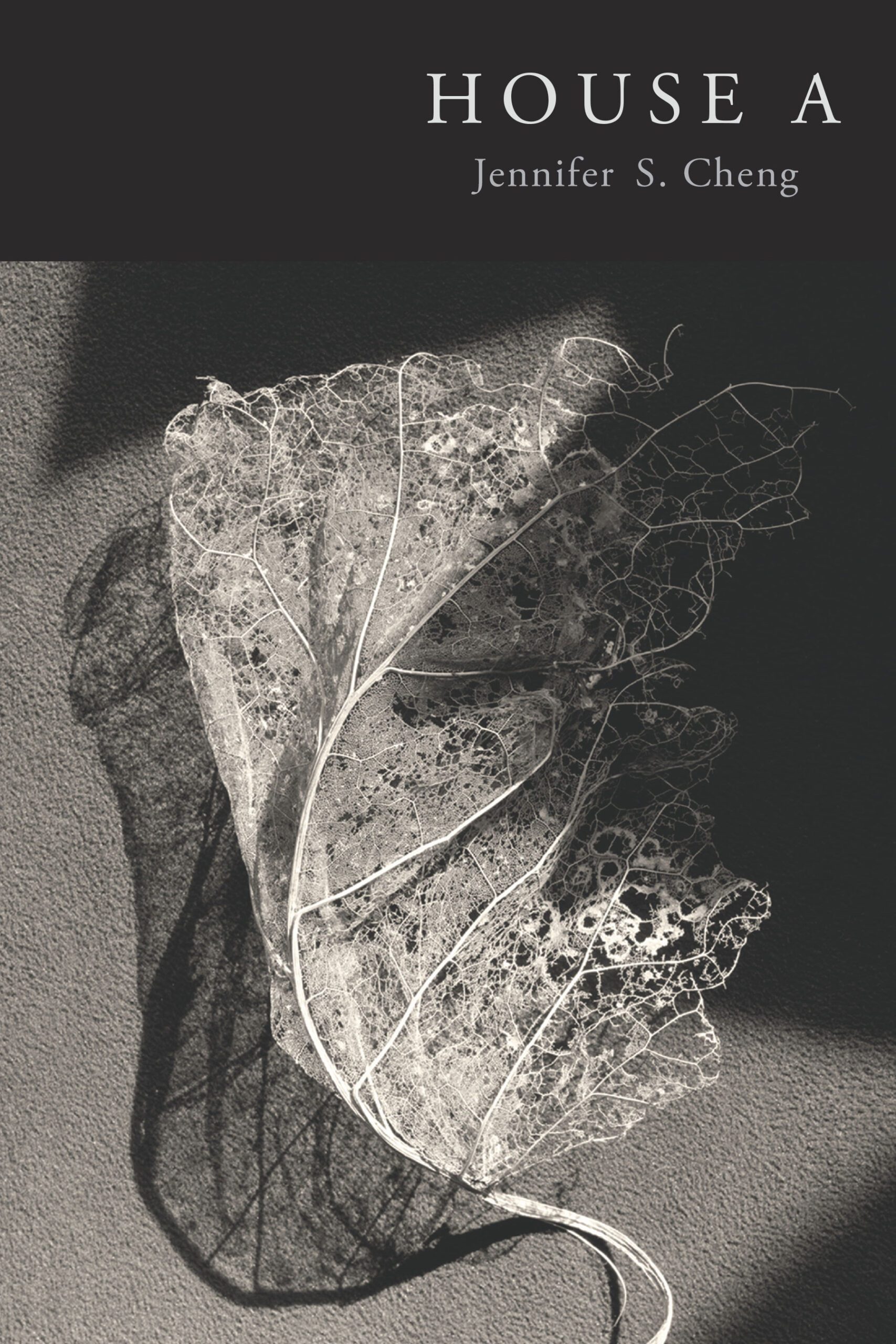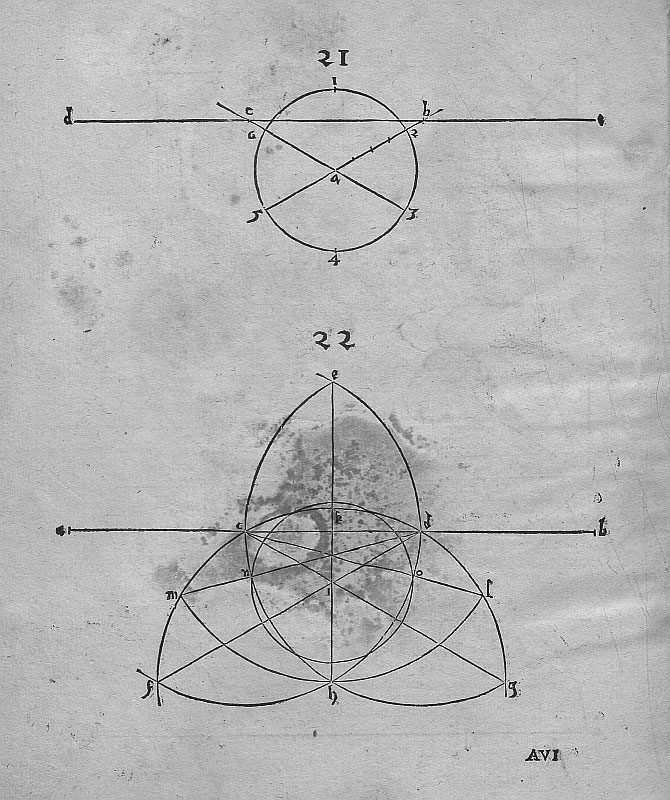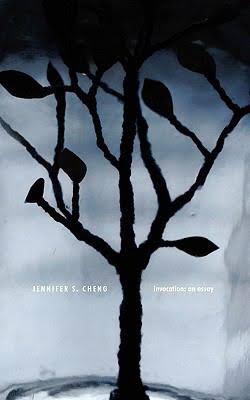
“Geometry,” writes poet and essayist Jennifer S. Cheng in her 2016 poetry collection House A, “is a configuration of parts, each asking itself: How do I adhere?” It is question that reverberates throughout the book’s three sections, a question asked out of the experience of growing up in an immigrant home, immersed in an “alien” language and culture, a home built on displacement and longing. Cheng’s poems, which shift between verse and prose, are at once airy and anchoring, precise and dreamlike, intellectual and intuitive, strange and familiar, maps to nowhere. House A is both ineffable, a ghost house, a kind of template, as well as House A, “A” as in America, our large and complicated home.
Claudia Rankine, who selected Cheng’s manuscript as the winner of the 2015 Omnidawn 1st/2nd Poetry Book Contest, describes the book as “an exquisite exploration of the ability of diasporic longing to live within a continuous and full life” focused on the “construction of love and love’s capacity to transform unimagined locations.”
Jennifer S. Cheng is a poet and essayist with MFA degrees from the University of Iowa (in nonfiction) and San Francisco State University (in poetry) as well as a BA from Brown University. A US Fulbright scholar, Kundiman fellow, and Pushcart Prize nominee, she is also the author of an image-text chapbook, Invocation: An Essay (New Michigan Press). Her writing has appeared in Tin House, AGNI, Web Conjunctions, Mid-American Review, Black Warrior Review, The Normal School, and elsewhere. Having grown up in Texas, Hong Kong, and Connecticut, she currently lives in San Francisco.
We emailed over the course of a few months, slowed by the shock of the election results, the holidays, and the storms that have been ravaging Northern California (where I also live).
***
The Rumpus: Can you start by talking a bit about the title? What is “House A”?
Jennifer S. Cheng: It is the first house, house of beginnings, house of embodied language, house archetype, foundational house, primordial house, house of our first cosmos, house with our angled roof, house with an apex.
Rumpus: Throughout the book, you are constantly defining and redefining the “house” and the “home”—it is, alternately, the sky, the body, a nest, a “hemispherical world,” “a schism or groove we can grow / through,” the mother’s voice, even language itself. At first I was very concerned with each definition, and then, as the definitions accrued, I began to suspect that perhaps the point was not the definition but this accrual of definition—that perhaps you were attempting to explode the very idea of definition through an accumulation of it, that you were “pointing and naming” only because that is what we have learned to do, only because there was no real alternative in language.
Cheng: In general I think I tend to write in iteration and accumulation for that reason: a singular, all-encompassing word never seems to exist. There is never one perfect boundary in language that is true enough, so all we can do is keep naming various points and angles, keep accumulating pieces and fragments.
I am saying something here about language and truth, but also related is the poetics of refraction, which to me is about de-centering sightlines, disrupting linearity, shattering normalized boundaries and constructs. Recently a reviewer said my writing is like the “immigrant’s decentered network, a collection of ands and ors that are too intimate, too contradictory to build up to something as singular and definitive as a thesis.” Perhaps the fluidity of identity, of our categories, becomes its own kind of meta-thesis. Why should we pretend that “home” or “American” are monolithic instead of multi-faceted, complex, and slippery? In this way to “explode the very idea of definition” is a political act.
Rumpus: I love that. Could you talk more about the role of politics in your work, or perhaps about the relationship between poetry and politics more generally? What do you think will be the role of poetry over the next four years?
Cheng: “Next four years” sounds terrifying. The last few months have felt like such an outward and inward experience of lament… It’s been a wake-up call for what has always been there. To me, the personal (and poetical) is inescapably political and vice versa. Every utterance is informed by social, cultural, and political forces and in turn carries social, cultural, and political implications. We are increasingly aware of this; we see more plainly how “political climate” is linked to personal and poetical climates.
I don’t think this means all poetry must make loud proclamations to be valuable. Carl Phillips said in a recent essay that “[t]o insist on being who we are is a political act,” and I absolutely believe this is why we need the full spectrum of literary art—whether thunderous or quiet, headstrong or windswept—from people who have been suppressed or invisible. We are where we are now because a swath of people in this country are convinced the answer to their problems is to subjugate and marginalize other people. Part of the response in poetry has been to focus our attention on those they are attempting to erase, to render seen what has been unseen.
In my own work I find that I have always been obsessed by undercurrents, shadow layers, subtexts. It is how I navigate through the world, where the slightest shifts feel like unsettling storms to me. I think this is why the book is preoccupied with sleep, water, weather, dust, angles, shadows. My acute sensitivity is likely related to being a fearful person, inching around the world in small and vigilant movements, but perhaps it can also be a strength in my writing. The role of politics in my work: I write toward the ambiguous, elusive things in the corner of the room.
Rumpus: Your book is made up of three sections, which take up progressively less space on the page. For me it read as if the need for solidity was diminishing as the book progressed, as the speaker aged, and as the idea of home—once very stable—evolved into something more tenuous. After all, in the final section, you write: “Held between two skeins, the air becomes a cradle.” How would you describe the development of the book across sections? Did you write them in that order? And how did they find their final shapes?
Cheng: Something that has been scary and then beautiful is letting go of the book because, as other wise writers have reminded me, it belongs to readers now (this is my way of saying that your reading of the book is lovely and meaningful, and I want to let it be).
I will say: the ordering of the sections came together intuitively and bodily, with the help of a workshop, “Imagining the Book” taught by Barbara Tomash. I wrote the first section first, and then the second and third concurrently. I will say: the first section operates by way of water/sleep, the second by incantation/geometry, the third by way of blueprints that merge ghosts/angles. Maybe there are more angles perforated with air as the book progresses.
Rumpus: As you mention, the ocean and the sky—water and air—figure prominently throughout the book. Can you talk about their significance to you, and how you see them as functioning in the text?
Cheng: Ocean has always been a preoccupation of mine—I have lived adjacent to the water on both sides of the Pacific—and of course it carries so much significance for immigrants. Ocean is distance crossed, what is hidden and lost, what cannot be separated or parsed, what immerses us. Sky is its opposite but equal mirror; it is the cosmos that forms our roof, it brings us various weathers, it feels far away, and yet we see under it, breathe it all the time. There is something about vastness in both—fundamental elements that spread, spill, envelop. We can’t escape it. In the book, they are images and metaphors but also formal properties: cadence, tone, texture. (As I write this, the rain outside is falling in waves.)
Rumpus: You use actual diagrams as well as the language of the diagram and of measurement frequently in these poems. I often had the sense that part of the work of this book was an attempt to measure—in both actual and poetic units—the immeasurable. What was your intent in including the actual diagrams (and other images) in the book? How do you see them as interacting with the text?
Cheng: To me, the images in the series “How to Build an American Home” are as essential as the text. The meaning and experience of each image is shaped and sharpened by the text and vice versa. I am interested in the tension of trying to map literal dimensions against the intangible: the shadows, stains, atmospheres of our lives. You articulate it beautifully—“an attempt to measure, in both actual and poetic units, the immeasurable”—isn’t that what we are always doing?
I also wanted to make an argument about the maps we have considered to be instructive and definitive; that is, I wanted to blur our blueprint for how we define American Home, to replace it with something more murky, more intimate and true to me. Looking back, I chose images that are not straightforward diagrams but might only be considered “instructional” in a skewed or off-centered way—cross-sections of plants, geometric explorations, land surveyor photographs. Each image carries some kind of wound for me. I’ve noticed that many of the images even contain literal blemishes, page seams, faded parts, which became focal points for the accompanying text. What does it mean to navigate by way of these textures?
Rumpus: You say, “Each image carries some kind of wound”—what kind of wound or wounds?
Cheng: I’m referring here to Roland Barthes, who uses the term punctum in Camera Lucida: “this element which rises from the [image], shoots out of it like an arrow, and pierces me… this wound… that accident which pricks me (but also bruises me, is poignant to me).” It’s inexplicable, which I suppose is the point of an image as opposed to text. The wounds in my images are related to some emotion, sense, or texture of home: something mournful, tender, longing, hidden, ghostly, insistent, puncturing. It is not only the content of the image but the grain, the hardness or softness of the lines, the creases and discolorations.
For example:
In this image it is the stain that moves me, along with the fragility yet certainty of the lines. What is being charted here? In the accompanying text, the stain becomes “a forest of moon, marsh, bird” that we grow inside the house.
Rumpus: Could you also talk a bit about how you decided to include images—was it always part of your plan, was it suggested, or…? What texts were you using as a model?
Cheng: I am a visual person and have always been drawn to literary work that incorporates visual elements; this might be actual artifacts, but placement of text and blank space can also function like images. As an undergraduate, I took a workshop called “Lyricism and Lucidity,” which brought together lyric and essay, word and photograph, and ever since I have been working with the interaction of image and text. How do the different modes influence and alter one another? How might the visual capture something the textual cannot convey? In what circumstances does the need for a multiplicity of modes arise? Years ago in utter alienation I was having trouble formulating language to describe a particular experience of cultural silence, so I “wrote” an essay consisting of photocopied images, and it wasn’t until I combined these images with my splinters of text that it felt wholly articulated. It became a chapbook published by New Michigan Press called Invocation: an Essay, in which fragments of text, family photographs, found images, and white space haunt one another to create meaning. On each page, the placement of text, image, and/or white space carries a specific tenor that has an impact on its reading: certain images needed to be lower or higher on the page, and there needed to be smaller or greater space between certain fragments of text and image.
In House A, I became interested in visual artifacts as prompts and talismans. I have described this in Poets & Writers—can I quote from it as it relates here?
I noticed that I was keeping collections of images close to my writing process… houses with A-shaped roofs, geometric figures, and maps/diagrams/blueprints… These textures, atmospheres, and tones were ways for me to enter and re-enter my writing: a specificity of feeling to write toward; a ‘wound’ to unearth; an amulet to remind me of my goals; a specter to seep unconsciously into the language. The visual artifacts were at various moments prompts to set up the emotion of my writing, and they were also ghosts to haunt my work.
I didn’t have a specific model at hand, but Theresa Hak Kyung Cha’s Dictee and John Berger’s collaboration with Jean Mohr, Another Way of Telling, have always been important books to me. They taught me that an image can function as a fragment in the same way that text does.
Rumpus: The second section is subdivided into twenty-six sections that are each titled for a letter of the alphabet. This made me think about the experience of growing up in an immigrant home, with parents who didn’t necessarily speak English. In this context, I read the alphabet section as an attempt to make the Latin alphabet your own, to claim each letter. Can you speak about the decision to use the alphabet? What is the connection between each letter and the ensuing lines?
Cheng: Again, I love your reading and do not want it spoiled in any way. I keep feeling like some things should be left in the dark. Certainly I was thinking of the alphabet as a child’s incantation, a child’s learning. I wasn’t necessarily cognizant of the intention to reclaim, but I think there’s truth there. I was also thinking of schematics: Floyd Cheung in The Massachusetts Review described this section as “a refracted language of mathematics… a mathematical proof” where the reader is asked to “conjure an imagined reality… and then… to perform operations on it, taking angles, filling it with air, and watching it hang.” A friend wrote in an email that it was like a “time lapse videos of flowers blooming… [but instead] a house as it gets constructed, and there’s real weather inside of it.”
Rumpus: I notice in your answers a tendency to deflect to critics and other voices. You said earlier that the book “belongs to readers now,” but do you have other reasons (creative or otherwise) for resisting interpretation of your work, for wanting it to remain, in some way, mysterious? I guess I’m also interested in process here—in how you generate, revise, in whether or not you are working day-to-day “in the dark” so to speak.
Cheng: Working “in the dark” is exactly my wish every day! This question makes me feel naked. There is something sacred about the dark, what we do in the dark, wanting to preserve that. Rebecca Solnit and Fanny Howe have both written wonderfully on the importance of darkness, wandering, mystery, lost-ness. My poetics, which is also my worldview, revolves around something contradictory in how darkness and bewilderment is where we find ourselves closer to truth, perhaps because our lives are so constrained elsewhere by an emphasis on linearity and certainty that we need its opposite; or perhaps moreover because there is knowledge that lives in the unconscious and in the body; and perhaps in part because truth itself always carries a shadow, an unsayable complexity and opacity. I think of dark matter and dark energy: there are people who believe science is a matter of what we cannot explain yet, and then there are those like me who believe science and poetry are after the same thing, which is a thing that will always elude us.
I suppose part of my reticence to over-explicate or prescribe to the reader is that I sense how the gaps and silences in my writing are also spaces for the reader to exist and to converge with all that is slippery, the simultaneous tethering and untethering, which is my favorite part as a reader. Meaning-making is ultimately a collaboration between writer and reader, a beautiful and blurry space of collision and communion.
In terms of my writing process, working in the dark means instinctually collecting fragments and assembling them as constellations, letting the body and process of discovery carry me. It means a poetics of blank space. Revision is where I am more intentional in shaping things, but that doesn’t mean I don’t leave the holes where they are.
Rumpus: You write “the house is physically inscribed on / our bodies” and later “the body is a plane that has already been inscribed. Newspaper stories of bodies bent over, bodies in shame, a continuation of angles yet to be unlearned.” Do you see the house as a site of inherited trauma for the “children of immigrants”? If so, can the house also be a place of shelter and comfort?
Cheng: A house may be all of these things, the house being a complicated thing.
Rumpus: Where do you live now? Would you call it an “American home”?
Cheng: Lately I have been living in a home that feels like it has been swallowed and thrown; a body mauled, devoured, disclosed, leaking.
Here is the part I want to put in multiple parentheses because how do I answer this question today except with heartbreak and anger? I wished to believe in America as an aesthetic collaboration—a wild experiment of people of great difference struggling to make a home. But “American” is its own multi-layered term, and lately I have been thinking about what it means and more importantly who decides: Is it a passport, a birthright, a desire for a freer life, or the fact that one stays, forgiving its sins or in spite of it all? Is it how closely the color of my skin approximates that of its “founding fathers” or of the people who were on this land before that? Is it the loss of an accent or that we all have one? Is it its history, more terrifying than our textbooks say; capitalism and an unquestioned faith in self-interest; or the intention, hypocritical and failing, to be a place of equity and humanism? Is it a constant negotiation of myth? Maybe my real hope is that this country, in comprising exceptionally of difference, is an opportunity to be a place where there is no monolith at its center, no normalized dominant culture of power. At its worst, America has always been a place of oppression, hegemony, colonialism, greed; but the best of its people have sought to make it less so, to address its wrongs, to make it a home for disparate homes, huddled masses, tired, poor, wretched, homeless. I realize it is optimistic to want to claim “American” when it does not always want me, but the idealist in me wants to assert that my home is more American than the president’s home.
Rumpus: At the end of the acknowledgments, you thank the “Invisible House.” Is that a house that exists in your imagination, or is it a partially real place? Can you describe it for us?
Cheng: It is, maybe, the home we are all longing for. In the book I allude to the strange wave of homesickness I feel from time to time—it is a sensation of hollowness in my gut—such a specific but inexplicable longing that I can only assume somewhere is a home that fills it.
***
Author photograph © Gary Tsang.







